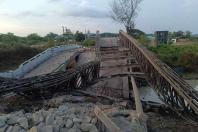VIENTIANE (Vientiane Times/ANN) - Travelling around the provinces of Laos is one of life’s most rewarding pleasures which many people speak rapturously about.
I am one such person and love to travel whenever I get the chance.
About five years ago, most of my friends and I decided we would try to visit several provinces each year. At this point in time life was comfortable and it was a case of easy come, easy go.
But now we’re counting the cost and are afraid of how the bills will mount up as we see our salaries shrink and are forced to count every kip that leaves our pockets.
People who take to the road on a regular basis say local people don’t need much money to survive. They seem to be doing okay and that’s just fine. But I don’t have any money to spare and can no longer afford to go travelling.
Travel in the winter months is especially appealing, and the chilly weather in the northern provinces is invigorating. At the end of the rainy season in October, the cool weather and green fields are a joy, and the clear air enables travellers to marvel at the mountain scenery.
As an aficionado of road trips I am sometimes unable to stay at home when my friends try to talk me into exploring somewhere new.
When I’m with them I feel a bit uncomfortable because I don’t have much money. But I go along with them, smile, and pretend otherwise. Nobody wants to stay at home because it’s boring.
One of my friends, Mr Chandy Soukhom, recently observed that he was almost 40 but still had not seen all of the provinces.
“My meagre monthly salary only allows me to save a small amount,” he said.
So far he’s been to Luang Prabang, Champassak, Savannakhet and Khammuan provinces, with a trip to Xieng Khuang last month being the most recent addition to the list.
He and some friends rented a minibus for the three-day, two-night visit to Xieng Khuang but I declined to go with them.
Seven hours after leaving Vientiane and about 50km before reaching Xieng Khuang, the minibus stopped for the passengers to stretch their legs at Nong Tang, a roadside lake.
The lake was very refreshing and they stayed there for about an hour.
“We were really pleased just to sit and eat and drink in a restaurant as Lao music played in the background,” my friend said.
There are two restaurants at the lake, with both offering good food and friendly service. An added attraction is that prices are reasonable.
As the friends waited for their food, they felt the time was right for a few glasses of beer, as is customary in such circumstances.
Nong Tang is a picturesque lake surrounded by limestone hills. Many people who live nearby come here to fish, and it’s also a popular picnic spot.
Children come here to swim, and some women wash their clothes at the lake’s edge.
“I really enjoyed eating, drinking, listening to music and watching the children swim,” he said.
Almost everyone travelling on this road stops here, as it’s a long way to Xieng Khuang.
Xieng Khuang provincial capital is about 435km north of Vientiane. The road is steep and winding, and travellers are treated to the awesome beauty of precipitous green hillsides.
Many people don’t relish the thought of going there by road as they are fearful they will suffer from motion sickness because of all the bends.
But now the province has an added attraction since the enigmatic Plain of Jars was added to UNESCO’s list of World Heritage Sites last month. This was a proud moment for Laos and no small triumph after years of work.
Laos’ first World Heritage Site was officially recognised by UNESCO in 1995 when Luang Prabang’s old town was listed. This was followed by the listing of the Vat Phou temple complex in Champassak province in 2001.










